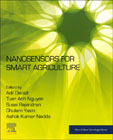
Nanosensors for Smart Agriculture
Denizli, Adil
Nguyen, Tuan Anh
Rajendran, Susai
Yasin, Ghulam
Nadda, Ashok Kumar
Nanosensors for Smart Agriculture covers new breakthroughs in smart agriculture, highlighting new technologies, such as the internet of things, big data and artificial intelligence. In addition, the book provides the many advantages of nanosensors over their micro counterparts, such as lower power consumption, higher sensitivity, lower concentration of analytes, and smaller interaction distances between the object and sensor. Sections provide information on fundamental design concepts and emerging applications of nanosensors in smart agriculture. The book highlights how, when cultivating soil, nanosensors and their wireless networks can be used for soil quality monitoring (moisture/herbicides/organic compound/trace metals monitoring in soil, etc. Other applications cover how smart nanosensors can be used for virus detection and hygiene/pathogen controls in livestocks, their use as active transport tracking devices for smart tracking and tracing, and other various applications, such as (i) nanochips for identity (radio frequency identification), (ii) food inspection, (iii) intelligent food packaging, and (iv) smart storage. This is an important reference source for materials scientists and agricultural engineers who are looking to understand more about how nanosensor technology can be used to create more efficient and sustainable agricultural systems. Outlines the fabrication and fundamental design concepts of nanosensors for agricultural applications Explains how nanosensors are being used throughout the agricultural cycle - from crop growth to food manufacturing Assesses major challenges surrounding the application of nanosensors to agricultural applications in mass scale INDICE: Section I Basic principles 1. Nanotechnology for agriculture: an introduction 2. Nanotechnology and sustainable agriculture 3. Microbiology in agriculture: an introduction 4. Methods for design and fabrication of nanosensors 5. Magnetic nanomaterials-based biosensors 6. Nanoparticles-based sensors for agricultural application 7. Electrochemical sensors for agricultural application 8. Current commercial nanosensors and devices/products used in agriculture 9. Soil moisture nanosensors 10. Detection and evaluation of trace metals in soil using nanosensors Section II Nanosensors for soilquality monitoring and control 11. Nanosensors for pesticide detection in soil 12. Application of nanosensors for pesticide detection 13. Nanosensors for detecting nutrient losses from soil (as gaseous ammonia and nitrous oxide, and/or soil leachates as nitrate and phosphate) 14. Nanosensors for the detection of heavy trace metals in soil 15. Nanobiosensors for soil microbial detection 16. Nanosensors for microbial detection in soil 17. Wireless nanosensor network for agricultural applications 18. Nanosensors for controlled release fertilizer Section III Nanosensors for growing crops 19. Nanosensors for plant health monitoring 20. Wireless nanosensor network for irrigation control 21. Plant health monitoring using nanosensor system 22. Role of nanobiosensors and biosensors in plant virus detection 23. Nanosensors for animal health monitoring 24. Nanosensors for virus detection Section IV Nanosensors for livestock farming 25. Virus detection using nanobiosensors 26. Animal health monitoring using nanosensor networks 27. Advanced nanosensors for virus detection 28. Use of nanosensor technologies in the food industry 29. Nanosensors for food logistics Section V Nanosensors for agrifood manufacturing 30. Nanosensors for food inspection 31. Application of nanosensors in food inspection 32. Nanosensors for intelligent food packaging 33. Food products safety
- ISBN: 978-0-12-824554-5
- Editorial: Elsevier
- Encuadernacion: Rústica
- Páginas: 824
- Fecha Publicación: 25/11/2021
- Nº Volúmenes: 1
- Idioma: Inglés
